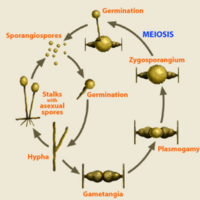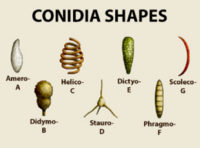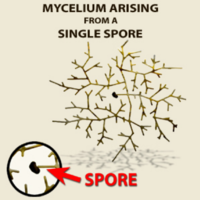Adaptations

Like the animals and plants which occur in the Arctic, polar fungi have evolved physiological and morphological characteristics to aid their survival. Instant cold-hardiness is a characteristic common to all species of fungi that grow in the Arctic. Periodic hard frosts in mid-summer make it imperative for polar fungi to be able to resume growth immediately in the brief growing season. To survive low temperatures fungi produce substances, such as glycerol, proline, and trehalose, which act as cryoprotectants. These solutes protect hyphal cells from potentially lethal shrinkage and ice crystal formation.
In the polar deserts of Canada's High Arctic, the lack of water is a constant threat to survival. However, xerophilic fungi are capable of survival and growth under these conditions. In fact, some of these fungi can grow and reproduce with water activity (water available in the substrate for use) as low as 0.65 (most vascular plants wilt when water activity falls below 0.98). This tolerance of water scarcity is aided by compounds such as proline, glycerol, and mannitol, which enable enzymes to function efficiently under water stress.
The third major threat to survival in the Arctic is ultraviolet (UV) radiation from the sun. UV-B radiation splits the water molecules in hyphal cells into free radicals, which can damage DNA. To avoid this effect, some arctic fungi have developed a mycelium and spores with dark pigmentation, which UV-B rays cannot readily penetrate. Other arctic fungi have developed mechanisms enabling the rapid repair of damaged DNA.
To learn more about polar fungi adaptations, please browse below.
Frigid Fungi
|
|---|
|
Instant cold-hardiness is a characteristic common to all species of fungi that grow in the Arctic. Periodic hard frosts in mid-summer make it imperative for polar fungi to be able to resume growth immediately in the brief growing season. Thus, Arctic fungi have evolved spores that are resistant to many environmental extremes, including freezing, starvation, and dessication. To survive low temperatures, fungi produce substances – glycerol, proline, and trehalose – which act as cryoprotectants. These solutes allow fungi to grow at temperatures as low as -5°C, protecting hyphal cells from potentially lethal shrinkage and ice crystal formation. |
I’m Not Thirsty!
|
|---|
|
In the polar deserts of Canada's High Arctic, the lack of water is a constant threat to survival. However, xerophilic fungi are capable of survival and growth during periods of water stress. In fact, some of these fungi can thrive with water activity (water available in the substrate for use) as low as 0.65, whereas most vascular plants wilt when water activity falls below 0.98! This tolerance of water scarcity is aided by compounds such as proline, glycerol, and mannitol, which enable enzymes to function efficiently under water stress. |
Sunblock for Fungi
|
|---|
|
Besides harsh environmental conditions, another major threat to survival in the Arctic is ultraviolet (UV) radiation from the Sun. UV-B radiation splits the water molecules in hyphal cells into free radicals, which can damage DNA. To avoid this, some arctic fungi have developed a mycelium and spores with dark pigmentation, which UV-B rays cannot readily penetrate. Other Arctic fungi have developed mechanisms enabling the rapid repair of damaged DNA. |
Fungal Biology
Classification
|
|---|
|
Two main groups of higher fungi are distinguished on the basis of structures associated with sexual reproduction. They are Zygomycota and Dikaryomycota. Phylum ZygomycotaZygomycetes belong to the phylum Zygomycota. They reproduce sexually by the fusion of structures called gametangia (which arise from the hyphae) to form a zygosporangium, which contains a zygospore. Zygosporangia have thick walls, which protect the resting spores from extreme environmental conditions, such as those found in the Arctic. The mycelium of these fungi is typically well developed, haploid, multinucleate, and coenocytic (without cell walls separating the adjacent cells). The asexual life stage is more common than the sexual stage in these fungi. Asexual spores, called sporangiospores, are formed in sporangia at the tips of sporangiophores (stalks). Two orders of zygomycetes are found in the Arctic, the Mucorales and the Glomales. Phylum DikaryomycotaThe Phylum Dikaryomycota includes two of the best-known groups of fungi, the Ascomycetes and the Basidiomycetes. Both of these groups have multinucleate, haploid hyphae that are septate (divided by walls to provide strength and structure). These hyphae fuse with one another to exchange nuclei, and both ascomycetes and basidiomycetes have a dikaryotic lifestage in which each hyphal compartment contains two compatible nuclei, which coexist for a time without fusion. These fungi can reproduce rapidly by means of asexual spores called conidia. Conidia are modified hyphae that are formed singly, in groups or enclosed in masses, which develop below the surface of plant substrates. Conidia come in varied shapes, colours, sizes, and textures depending on the environment in which they live. So, how do you tell the difference between ascomycetes and basidiomycetes? There are several ways, but the simplest involves determining the difference between their sexual fruiting bodies. Ascomycetes Ascomycetes form a sac-shaped ascus that contains ascospores (sexual spores). These asci are contained in various types of fruiting bodies: apothecium (cup-shaped), perithecium (flask-shaped), and cleistothecium (closed, sphere-shape). Basidiomycetes Basidiomycetes form basidia (fruiting bodies) with four stalk-like structures, which each bear one basidiospore (sexual spore). |
Lifestyles
|
|---|
|
Fungi have developed varied strategies to obtain the nutrients needed to grow and reproduce. This has allowed them to invade numerous niches and colonize some of the world's least hospitable places. Some Arctic fungi form symbiotic mycorrhizalassociations with flowering plants. Others are parasites on plants, animals, or other fungi, and many simply feed on decaying organic matter – essential decomposers in Arctic food chains! BiotrophsBiotrophic fungi depend on a living host, but, unlike mycorrhizal associations, these species are not beneficial to their host. They have specialized hyphal swellings called appressoria, which adhere to the surface of their host. Following adherence, haustoria are formed (also specialized hyphal swellings), which penetrate the host cells and extract nutrients from the host plant into the fungal mycelium. The host is rarely killed, but its physiological processes and development may be altered. Because biotrophs depend on their hosts for nutrition, their growth parallels that of their host. This leaves the fungus with three choices: complete its life cycle in one growing season; segment its life cycle over several years; or grow in conjunction with evergreen tissue. Many plant pathogens are obligate biotrophs – they are biologically essential for survival – including the rusts (Uredinales), the smuts (Ustilaginales), and the powdery mildews (Erysiphales), all of which grow on Arctic plants. MycorrhizaMycorrhizal (myco="fungus"; rhiza="root") fungi form symbiotic relationships with vascular plants, in which the plant nourishes the fungus with organic molecules, while the fungus helps the plant to obtain water and inorganic nutrients. Essentially, the fungus extends the plant's root system and its ability to absorb nutrients in return for food! At least 85% of higher plants form mycorrhizal associations with fungi. In order to establish these relationships the hyphae of mycorrhizal fungi penetrate or envelop the root tissue of their host plant to create a functional interface for nutrient exchange. Those fungi whose hyphae develop around the root tissue are known as ectomycorrhiza(ecto="outside), while those whose hyphae penetrate and subsequently form hyphal clusters within the root tissue are called endomycorrhiza (endo="inside"). All Salix species in the Arctic have ectomycorrhizal associations, while most species of arctic Ranunculaceae have endomycorrhizal symbionts. NecrotrophsNecrotrophs are parasites, which live on and subsequently kill their hosts. Most necrotrophs produce toxins to destroy their hosts and are able to survive for long periods without a host. After killing their host, these fungi act like a saprotroph and degrade it. The asexual ascomycete genus Fusarium is a common necrotroph in the Arctic. SaprotrophsSaprotrophic fungi degrade dead organic matter (including fungi, plants, and animals) with the aid of extracellular enzymes. Some saprotrophs are specialists which grow on only one substrate, but others are generalists which thrive on many hosts. Some specialist species, which develop on and decompose dung, are called coprophilous fungi. Fungi are responsible for the decomposition of one-third of the organic biomass on the planet and, as such, are very important in nutrient cycling in Arctic soils. |
Morphology
|
|---|
|
The body of a fungus is made up of finely branched tubes called hyphae, which are collectively referred to as a fungal thallus or mycelium. Hyphal cells are long and thread-like. Their cell walls are composed of chitin, a long carbohydrate polymer that is also the main component of insect and crustacean exoskeletons. It provides the strength and rigidity needed for fungal hyphae to penetrate rock substrates and soil surfaces. |
Reproduction
|
|---|
|
Most fungi are able to reproduce both sexually (via meiosis) and asexually (via mitosis) by means of spores. Spores are often produced in huge numbers and vary in shape and size depending on environmental conditions. Moulds engage in asexual reproduction, whereas mushrooms are the fruiting bodies that produce sexual spores. One of the main objectives of the sexual stage is long-term survival, whereas dispersal is the main purpose of the asexual stage. The broad distributions of many fungal species is linked to their production of spores, which often travel thousands of kilometres through the air before they land and germinate. Water and animal vectors can also lead to the transfer of spores. Because their plant hosts are often sparsely distributed in the Arctic, effective spore formation and dispersal is essential to survival. Arctic fungi have developed spores that are resistant to many environmental extremes, and thus better adapted to life in the harsh northern climate. For example, the spores of many arctic species can survive freezing, starvation, and desiccation, grow at temperatures as low as -5°C, grow and reproduce during periods of water stress, tolerate oxygen concentrations as low as 2% (the air we breathe is 20% O2), and survive in both acidic and alkaline conditions (pH 1–9). |
Cool Facts
The Fungi kingdom contains some of the most interesting organisms on our planet. This is especially true in the Arctic, where harsh living conditions have resulted in super cool fungi facts. Please browse below to learn fun trivia about polar fungi.
Arctic Fairies
|
|---|
|
Is the Arctic home to fairies, the meeting place for leprechauns or the resting place for passing trolls? Two hundred years ago, many would have answered yes upon seeing a fairy ring in the tundra. A fairy ring is a circle of brownish grass surrounded by a circle of lush bright green grass. When conditions are right toadstools sprout up from this ring. In England, it was believed that these rings were tiny paths beaten by fairies as they joined hands and danced together and that toadstools grew around these rings so that the fairies could sit and rest their tired feet after a long night of dancing. Other mythological characters such as leprechauns and trolls, which were believed to consort with fairies, were also implicated in the construction and use of fairy rings. How are fairy rings really formed? A spore lands on the ground and germinates. The mycelium, which grows underground, spreads outwards in a circle. As it grows, it secretes enzymes to break down organic matter in the soil into soluble nutrients. At first, the grass takes advantage of these nutrients so that a ring of lush grass appears, but then the fungus absorbs the nutrients, starving the grass, and leaving a ring of dead grass on the inside edge of the growing mycelium. Periodically, mushrooms spring up just behind the outer edge of the mycelium. Rings are formed when the mycelium in the centre dies, nutrients are returned to the soil, and the grass re-grows. Rings can grow up to 20 cm/yr and reach more than 10 m in diameter. One fairy ring in France is more than 600 m in diameter and more than 700 years old! Fairy rings in the Arctic are not so large, but do occur in relatively moist areas where grasses and sedges are dense. Various species of basidiomycetes, including those in the genus Marasmius, are responsible for arctic fairy rings. |
Buried Treasure
|
|---|
|
Do indigenous people hunt for buried treasure in the tundra? Sure they do! Truffles (Tuberaceae) have long been a source of food and flavouring for the Inuit. Since they are so hard to find, they are very valuable. Truffles are formed underground and use animal vectors to transport their spores. As such, these fungi have very strong odours that attract animals to them. When going on a truffle hunt it's a good idea to bring along a dog; they are much better at sniffing out truffles than humans! |
Frozen Fungi
|
|---|
|
Fungi held hostage in ancient glacial ice for 140,000 years brought back to life! Glacial ice is capable of sheltering microorganisms for a long time. The icy environment protects spores and hyphae from UV radiation, oxidation and chemical damage. Recently scientists have isolated and revived fungi that were recovered from ice cores up to 140,000 years old! Many species of ascomycetes including Penicillium, Cladosporium, and Aspergillus have been identified, as well as one genus of basidiomycete (Pleurotus). These frozen fungi may provide scientists with insights on the biology, ecology, diversity, and evolution of arctic fungi. |
Fungal Workout
|
|---|
|
Which fungi do pushups? Earthstars! Unlike their passive relatives the puffballs, earthstars have three outer layers. When it rains, the outer two layers uncurl and form a star with 4–12 points, while the inner layer remains intact, enclosing the dry spore mass. The points spread out and push aside debris that may inhibit the "puffing" mechanism, and push the spore-filled sac up off the ground. When the ground dries, the points recurl and the sac lowers. |
Fungal Workout
|
|---|
|
Which fungus carries a shotgun? Pilobolus! To disperse its spores Pilobolus uses a "shotgun" to blast them as far away as possible. Pilobolus lives in dung, which may not sound like an appealing lifestyle, but without decomposers like Pilobolus we would soon be knee deep in it! In order to grow in dung, fungal spores must be eaten by an herbivore while it is grazing. The tough spores of Pilobolus pass through its digestive system unharmed and begin to grow as soon as they are excreted. Because herbivores (with the exception of rabbits) don't eat their own dung, Pilobolus has evolved a way to shoot its spores up to 2 metres. The "shotgun" is a stalk (sporangiophore) bearing a swollen tip, which contains a mass of spores (sporangia). At the base of the swollen tip is a light sensitive structure, which orients the growth of the stalk towards the Sun. Water pressure in the stalk and swollen tip builds up to more than 7 kg/cm2 (100 lb/square inch) before the tip explodes and the sticky spores are hurled out onto the grass where they will be eaten once again. Other coprophilous fungi found in the Arctic, such as Ascobolus and Podospora, have similar mechanisms to distribute their spores. |
There's No Place Like Dung...
|
|---|
|
Most major groups of fungi include some species which specialize in exploiting dung. These dung specialists, including those in the Arctic, exhibit a true ecological succession in which various fungi tend to produce spores in sequence. The zygomycetes appear first, followed by the ascomycetes, and finally the basidiomycetes. At first it was hypothesized that this succession was a nutritional one. The zygomycetes, first to appear, germinate quickly and utilize the simple sugars and hemicellulose that are readily available in dung. Once the simple sugar sources are metabolized, the zygomycetes disappear and the ascomycetes appear, feeding on the cellulose found in dung. The ascomycetes are then replaced by the basidiomycetes, which utilize cellulose and lignin. This theory seemed to fit with the observations made, but it ignored two important factors: variation in the growth and sporulation rates of different groups of fungi, and competition between dung lovers. A second hypothesis was advanced, this time based on the time it takes for each fungus to fruit. The simple sporangiophores of the zygomycetes develop quickly and require less nutritional requirements than the fruiting bodies of the ascomycetes. Basidiomycetes require the largest amount of energy and nutrients to produce their fruiting bodies and thus they take the longest time to appear. This alternate hypothesis still neglects interspecific competition on the dung and the fact that some species of fungi act antagonistically towards others. The succession of coprophilous fungi on dung is easy to observe. Just place some fresh or weathered dung in a sealed container with distilled water, leave it at room temperature, and watch it grow. The succession from zygomycetes through basidiomycetes should occur over three to four weeks. |




